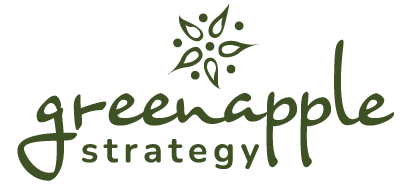When was the last time you bought something without reading a review first? The same is true for your customers. They want social proof before committing.
Whether you’re a B2B brand with a complex sales cycle or a B2C business focused on customer loyalty, your reputation drives decisions. And your customers? They’re your most powerful marketers.
That’s why review and testimonial collection, when done thoughtfully, isn’t just a helpful business practice. It’s a reputation marketing strategy. The key is asking for feedback in a way that’s strategic, efficient, and engaging without coming across as pushy or impersonal.
This has become a core marketing tactic for several Green Apple clients. For example, The Gardner School’s “Share the Love” campaign nearly tripled the amount of online reviews the school received while also strengthening relationships with current families.
After reviewing the success of this campaign and others like it, here’s what we’ve learned about building a review and testimonial collection process that strengthens your brand and boosts long-term growth:
Start with a Strategy: What Do You Want from Your Reviews?
Before you start asking for feedback, get clear on your goals. What do you hope to learn or showcase?
- Are you trying to understand the customer journey better?
- Want more credibility on your website or sales materials?
- Need user-generated content for a new campaign?
- Curious how a product or service is performing post-launch?
Once you know what you’re looking for, it’s easier to tailor your questions and choose the best channel to reach your audience.
Bonus tip: Make sure you know how you’ll use the feedback. Whether it’s for internal customer service improvements or external marketing, you’ll collect stronger, more actionable insights if your team is aligned on the end goal.
Timing is Everything: When to Ask for a Review or Testimonial
The timing of your request can make or break your response rate. While there’s no one-size-fits-all solution, there are a few best practices to help you decide when and how to follow up:
Immediately After a Positive Interaction
If a customer expresses satisfaction during a conversation, in an email, or on a support call, that’s your cue. Follow up with a quick, personal email thanking them and inviting them to leave a review.
2–3 Days After a Purchase or Service
Send an email once the customer has had a chance to use the product or experience the service. For B2C businesses, this might be a standard post-purchase email. For B2B, it might be part of your client check-in process.
During a Campaign or Seasonal Push
Running a product launch or gearing up for your busy season? Reviews and testimonials can act as social proof to fuel momentum. Consider running a quick social campaign or SMS series that encourages customers to share their stories.
After Milestones
For B2B businesses, reviews may make more sense after onboarding, at quarterly check-ins, or once ROI becomes visible. Frame it as a celebration of success and a chance to highlight their experience.
Ask the Right Questions, The Right Way
Open-ended, thoughtful questions give you rich, useful insights. But your tone and phrasing matter, too. Here’s how to strike the right balance:
DO: Be clear and specific.
Instead of: “What did you think of our product?” Try: “What made you choose our [product/service], and how has it helped you?”
You could even offer prompts for what to talk about: “Tell us what you loved about working with our team!” or “What results did you see after using our service?”
DO: Keep it short.
Focus on the one or two most important questions. If your ask feels like a chore, customers will skip it.
DO: Personalize your request.
Use the customer’s name. Reference their specific purchase. Show that this isn’t just a generic ask, it’s a real conversation.
DO: Make it easy to say yes.
If you want people to leave you a review, you need to make the process quick and easy. Be sure to include direct links to your preferred review platforms (Google, Yelp, G2, etc.).
DON’T: Sound desperate.
Avoid phrases like “We really need your help!” or “It would mean the world!” Instead, frame your ask in a way that empowers the customer: “Your feedback helps us improve and helps others make confident decisions.”
If you’re going to offer incentives, make sure to do it ethically. A small thank-you (like a discount code or entry into a giveaway) can go a long way.
DON’T: Ignore negative reviews.
Addressing negative reviews politely and professionally will demonstrate to other customers that you’re willing to engage when something goes wrong. Simple, effective communication can go a long way in turning an unhappy customer into one who gives you rave reviews.
Choose the Right Channel for Your Audience
Different channels may resonate better depending on your audience and the type of feedback you’re seeking. Here are a few to consider:
Email is still one of the most effective tools, especially when it’s personal. Avoid “noreply@” addresses. Instead, send requests from a team member or the CEO for a more authentic feel. Consider using email tools that allow for automation with customization.
SMS
With sky-high open rates, text marketing is great for quick polls or one-question surveys. Several of our clients use survey platforms such as Loyalty Loop or Delighted to capture customer feedback after a service call or other customer interaction. These platforms also offer the opportunity to track customer satisfaction over time through a Net Promoter Score data point.
Social Media
Polls, story stickers, or even posts encouraging feedback can turn followers into brand ambassadors. Make it fun and simple. Think one-click polls or “share your story” prompts.
Forms and Feedback Widgets
Great for passive feedback collection. You can embed testimonial forms on your website, add “Was this helpful?” buttons to blog posts, or include a review link in your email signature.
Build a Reputation That Markets Itself
Your customers’ stories are one of your most valuable assets. When you gather them thoughtfully and authentically, those stories become proof of your brand promise and a growth engine for your business.
At Green Apple Strategy, we help businesses like yours build feedback systems that fuel growth, strengthen reputation, and align with your bigger marketing goals. If you’re ready to get smarter about collecting reviews and testimonials, reach out.











